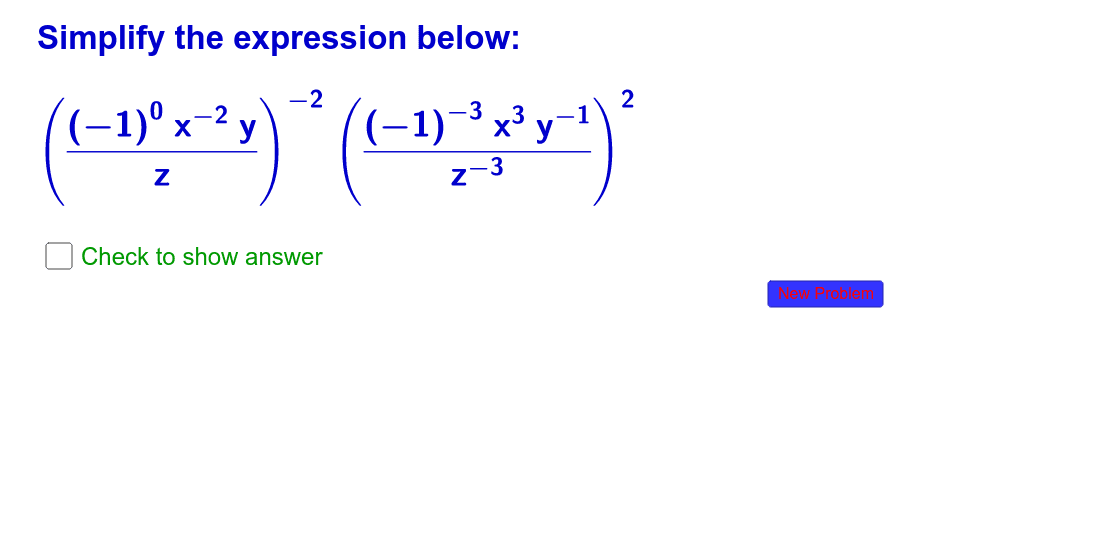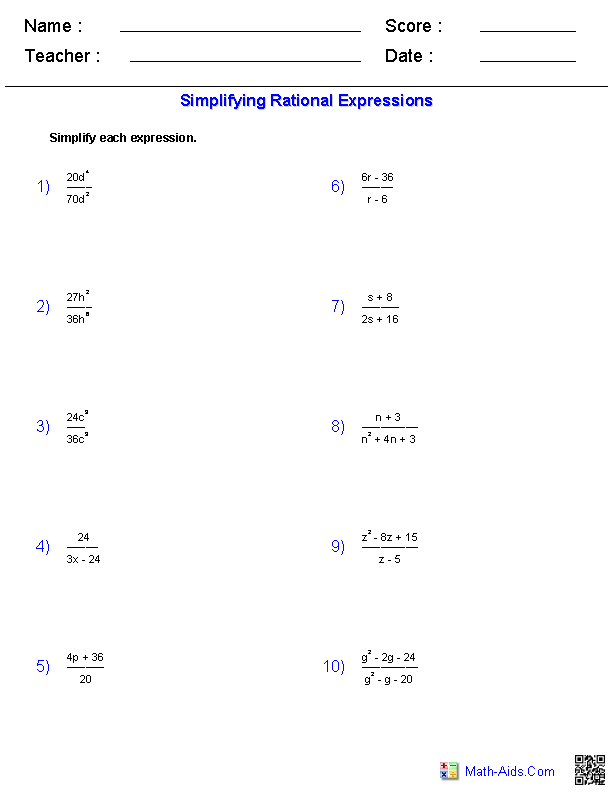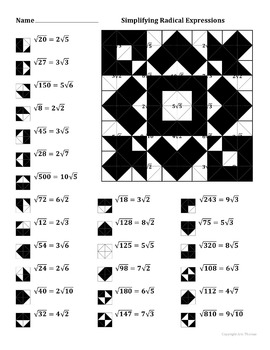Topic how to simplify rational expressions with exponents: Learn how to simplify rational expressions with exponents effectively with this comprehensive guide. Master the techniques of factoring, applying exponent rules, and canceling common factors to streamline complex expressions. This article provides step-by-step instructions and examples to enhance your understanding and proficiency in simplifying rational expressions with exponents.
Table of Content
- How to Simplify Rational Expressions with Exponents
- Table of Contents
- Introduction
- 1. Understanding Rational Expressions
- 2. Basic Exponent Rules
- 3. Factoring Numerators and Denominators
- 4. Simplifying Exponents
- 5. Canceling Common Factors
- 6. Handling Negative Exponents
- 7. Examples of Simplifying Rational Expressions
- 8. Tips for Simplifying Efficiently
- 9. Common Mistakes to Avoid
- 10. Conclusion
- YOUTUBE: Hướng dẫn đơn giản hóa lũy thừa với phân số, biến số, lũy thừa âm, phép nhân và phép chia trong toán học.
How to Simplify Rational Expressions with Exponents
When simplifying rational expressions with exponents, follow these steps:
- Factor Numerator and Denominator: Factor both the numerator and the denominator completely.
- Apply Exponent Rules: Simplify each exponent using the rules of exponents (e.g., power rule, product rule, quotient rule).
- Cancel Common Factors: Cancel out any common factors that appear in both the numerator and the denominator.
- Handle Negative Exponents: Move any negative exponents to the opposite side of the fraction using the reciprocal property.
- Simplify the Result: Combine like terms and simplify the expression as much as possible.
By following these steps, you can effectively simplify rational expressions with exponents, making them easier to work with and understand.

READ MORE:
Table of Contents
Introduction
Understanding Rational Expressions
-
Basic Exponent Rules
Power Rule
Product Rule
Quotient Rule
Factoring Numerators and Denominators
Simplifying Exponents
Canceling Common Factors
Handling Negative Exponents
Examples of Simplifying Rational Expressions
Tips for Simplifying Efficiently
Common Mistakes to Avoid
Conclusion
Introduction
Welcome to our comprehensive guide on how to simplify rational expressions with exponents. Rational expressions often involve complex algebraic terms with exponents, which can appear daunting at first glance. This article aims to demystify the process by providing clear step-by-step instructions and examples. By mastering these techniques, you'll gain confidence in simplifying and manipulating rational expressions efficiently.
1. Understanding Rational Expressions
Rational expressions are algebraic expressions that represent a ratio of two polynomials. They commonly appear in mathematical equations and problems involving variables. Understanding rational expressions is crucial for simplifying them with exponents effectively.
Key points to understand:
Rational expressions are written as \( \frac{P(x)}{Q(x)} \), where \( P(x) \) and \( Q(x) \) are polynomials and \( Q(x) \neq 0 \).
They can include variables, constants, and exponents in both the numerator and denominator.
Operations on rational expressions involve addition, subtraction, multiplication, division, and simplification.
2. Basic Exponent Rules
Understanding basic exponent rules is essential for simplifying rational expressions with exponents efficiently. Here are the fundamental rules:
Power Rule: \( (a^m)^n = a^{m \cdot n} \)
Product Rule: \( a^m \cdot a^n = a^{m+n} \)
Quotient Rule: \( \frac{a^m}{a^n} = a^{m-n} \) (for \( a \neq 0 \))
Zero Exponent Rule: \( a^0 = 1 \) (for \( a \neq 0 \))
Negative Exponent Rule: \( a^{-n} = \frac{1}{a^n} \) (for \( a \neq 0 \))

3. Factoring Numerators and Denominators
Factoring numerators and denominators is a critical step in simplifying rational expressions with exponents. Here’s how to approach it:
Identify Common Factors: Look for common factors in both the numerator and the denominator.
Factor Completely: Use techniques like grouping, difference of squares, or trial and error to factor each polynomial fully.
Apply Exponent Rules: Simplify exponents within each factor as you factor the expressions.
Cancel Common Factors: Cancel out identical factors in the numerator and denominator to simplify the expression.
Check for Remaining Terms: Ensure all terms are factored completely before proceeding to the next step of simplification.
4. Simplifying Exponents
Simplifying exponents within rational expressions is crucial for clarity and accuracy in mathematical computations. Follow these steps to simplify exponents effectively:
Apply Exponent Rules: Utilize rules such as the power rule, product rule, quotient rule, zero exponent rule, and negative exponent rule to simplify each exponent.
Combine Like Terms: Combine similar terms that have the same base and exponent to streamline the expression.
Factor Exponents: Factor out common exponents from terms in both the numerator and denominator to simplify the overall expression.
Use Reciprocal Property: Move terms with negative exponents to the opposite side of the fraction using the reciprocal property.
Verify Simplification: Double-check the simplified expression to ensure all steps have been correctly applied and that the final form is as simplified as possible.
5. Canceling Common Factors
Canceling common factors is a strategic method to simplify rational expressions by reducing complexity. Follow these steps:
Factor Numerator and Denominator: Factor both the numerator and the denominator completely.
Identify Common Factors: Look for identical factors that appear in both the numerator and the denominator.
Apply Cancelation: Cancel out these common factors by dividing them out from both the numerator and the denominator.
Check for Restrictions: Ensure that canceled factors do not introduce any restrictions on the variables (e.g., division by zero).
Simplify the Result: After canceling, simplify the resulting expression to its lowest terms if possible.
6. Handling Negative Exponents
Negative exponents can be simplified by rewriting them as positive exponents. A negative exponent indicates that the base should be taken as the reciprocal. The general rule is:
\[
a^{-n} = \frac{1}{a^n}
\]
Here are the steps to simplify expressions with negative exponents:
-
Identify Negative Exponents: Look for terms in the expression that have negative exponents.
-
Rewrite as Reciprocals: Rewrite each term with a negative exponent as the reciprocal with a positive exponent.
- Example: \( x^{-3} \) becomes \( \frac{1}{x^3} \).
-
Simplify the Expression: Combine the rewritten terms and simplify the resulting expression if possible.
- Example: \( \frac{a^{-2} b^3}{c^{-4} d^2} \) becomes \( \frac{\frac{1}{a^2} b^3}{\frac{1}{c^4} d^2} \), which simplifies to \( \frac{c^4 b^3}{a^2 d^2} \).
-
Check Your Work: Ensure that all negative exponents have been rewritten as positive exponents and the expression is fully simplified.
Here are some additional examples:
-
Example 1: Simplify \( \frac{3x^{-2}}{2y^{-3}} \).
- Rewrite negative exponents: \( \frac{3 \cdot \frac{1}{x^2}}{2 \cdot \frac{1}{y^3}} \).
- Simplify: \( \frac{3}{2} \cdot \frac{y^3}{x^2} = \frac{3y^3}{2x^2} \).
-
Example 2: Simplify \( (2a^{-1} b^2)^{-3} \).
- Rewrite negative exponents inside the parentheses: \( (2 \cdot \frac{1}{a} \cdot b^2)^{-3} \).
- Distribute the exponent: \( 2^{-3} \cdot a^3 \cdot b^{-6} \).
- Rewrite remaining negative exponents: \( \frac{a^3}{2^3 b^6} = \frac{a^3}{8b^6} \).
By following these steps, you can confidently handle and simplify rational expressions with negative exponents.

7. Examples of Simplifying Rational Expressions
Let's go through some detailed examples to understand how to simplify rational expressions with exponents step by step.
Example 1: Simplifying \( \frac{2x^3y^{-2}}{4x^{-1}y^4} \)
-
Factor and Simplify Each Term:
Rewrite negative exponents: \( \frac{2x^3 \cdot \frac{1}{y^2}}{4 \cdot \frac{1}{x} \cdot y^4} \) -
Simplify the Coefficients:
\( \frac{2}{4} = \frac{1}{2} \) -
Combine Like Terms:
\( x^3 \cdot x = x^{3+1} = x^4 \)
\( y^{-2} \cdot y^4 = y^{-2+4} = y^2 \) -
Final Simplified Form:
\( \frac{1}{2} \cdot \frac{x^4}{y^2} = \frac{x^4}{2y^2} \)
Example 2: Simplifying \( \frac{5a^2b^{-3}}{10a^{-4}b^2} \)
-
Factor and Simplify Each Term:
Rewrite negative exponents: \( \frac{5a^2 \cdot \frac{1}{b^3}}{10 \cdot \frac{1}{a^4} \cdot b^2} \) -
Simplify the Coefficients:
\( \frac{5}{10} = \frac{1}{2} \) -
Combine Like Terms:
\( a^2 \cdot a^4 = a^{2+4} = a^6 \)
\( b^{-3} \cdot b^2 = b^{-3+2} = b^{-1} = \frac{1}{b} \) -
Final Simplified Form:
\( \frac{1}{2} \cdot \frac{a^6}{b} = \frac{a^6}{2b} \)
Example 3: Simplifying \( \frac{3m^{-2}n^3}{9m^4n^{-1}} \)
-
Factor and Simplify Each Term:
Rewrite negative exponents: \( \frac{3 \cdot \frac{1}{m^2} \cdot n^3}{9 \cdot m^4 \cdot \frac{1}{n}} \) -
Simplify the Coefficients:
\( \frac{3}{9} = \frac{1}{3} \) -
Combine Like Terms:
\( \frac{1}{m^2} \cdot m^4 = m^{4-2} = m^2 \)
\( n^3 \cdot \frac{1}{n} = n^{3-1} = n^2 \) -
Final Simplified Form:
\( \frac{1}{3} \cdot m^2 \cdot n^2 = \frac{m^2 n^2}{3} \)
These examples illustrate the process of simplifying rational expressions with exponents. By following these steps, you can systematically simplify complex expressions.
8. Tips for Simplifying Efficiently
When simplifying rational expressions with exponents, efficiency is key. Here are some tips to help you simplify expressions more effectively:
- Understand the Rules: Ensure you have a solid grasp of exponent rules, including the product rule, quotient rule, power rule, and negative exponent rule.
- Factor Completely: Always factor both the numerator and the denominator completely. This makes it easier to identify and cancel common factors.
- Combine Like Terms: Use the properties of exponents to combine like terms. For instance, \(a^m \cdot a^n = a^{m+n}\) and \(\frac{a^m}{a^n} = a^{m-n}\).
- Simplify Step by Step: Simplify complex expressions in stages. Focus on one part of the expression at a time, simplifying as much as possible before moving on to the next part.
- Use Parentheses: Use parentheses to group terms and clarify the order of operations, especially when dealing with multiple exponents and variables.
- Check Your Work: After simplifying, check your work by substituting small values for the variables to verify that the original expression and the simplified expression are equivalent.
- Practice Regularly: Regular practice helps you become more familiar with different types of problems and improves your problem-solving speed and accuracy.
- Utilize Rational Exponents: Sometimes it's easier to work with rational exponents instead of radicals. Remember that \(a^{\frac{m}{n}} = \sqrt[n]{a^m}\).
Here is an example to illustrate these tips:
Example: Simplify the expression \(\frac{3x^4y^{-2}}{6x^2y^3}\).
- Factor both the numerator and the denominator: \[ \frac{3 \cdot x^4 \cdot y^{-2}}{6 \cdot x^2 \cdot y^3} \]
- Cancel the common factors: \[ \frac{3 \cdot x^{4-2} \cdot y^{-2-3}}{6} = \frac{x^2 \cdot y^{-5}}{2} \]
- Rewrite the expression using positive exponents: \[ \frac{x^2}{2y^5} \]
By following these tips and steps, you can simplify rational expressions with exponents efficiently and accurately.
9. Common Mistakes to Avoid
When simplifying rational expressions with exponents, it is crucial to be aware of common mistakes that can lead to incorrect results. Here are some key points to keep in mind:
-
Not Factoring Completely:
Ensure that you fully factor both the numerator and the denominator. For instance, when simplifying
-
Incorrectly Canceling Terms:
Only cancel common factors, not terms connected by addition or subtraction. For example, in
-
Ignoring Domain Restrictions:
Identify and exclude values that make the denominator zero. For example, in
-
Misapplying Exponent Rules:
Apply exponent rules correctly. For example, in
By keeping these common mistakes in mind and carefully checking your work, you can avoid errors and ensure your rational expressions are correctly simplified.
10. Conclusion
In conclusion, simplifying rational expressions with exponents involves a clear understanding of the properties of exponents and the ability to manipulate both numerators and denominators. Throughout this guide, we've explored essential concepts and techniques for effective simplification.
To summarize, here are the key takeaways:
-
Understanding Rational Expressions: Recognize the structure of rational expressions and the importance of each component.
-
Basic Exponent Rules: Apply the fundamental rules of exponents, including the product rule, quotient rule, and power rule, to simplify expressions efficiently.
-
Factoring Numerators and Denominators: Factorize the numerators and denominators to identify and cancel common factors, simplifying the expression further.
-
Simplifying Exponents: Use the properties of exponents to combine and reduce exponents within the rational expressions.
-
Canceling Common Factors: Systematically cancel out common factors in the numerator and denominator to achieve a simplified form.
-
Handling Negative Exponents: Convert negative exponents to positive by reciprocating the base, ensuring the expression remains in simplified form.
-
Examples of Simplifying Rational Expressions: Practice with various examples to reinforce understanding and mastery of the simplification process.
-
Tips for Simplifying Efficiently: Implement strategies to simplify expressions more efficiently, such as grouping like terms and using shortcut methods where applicable.
-
Common Mistakes to Avoid: Be aware of frequent errors, such as incorrect application of exponent rules or overlooking common factors, to avoid mistakes in simplification.
By following these guidelines and practicing regularly, you can confidently simplify rational expressions with exponents. Remember, the key is to understand the underlying principles and apply them consistently. Happy simplifying!

Hướng dẫn đơn giản hóa lũy thừa với phân số, biến số, lũy thừa âm, phép nhân và phép chia trong toán học.
Đơn Giản Hóa Lũy Thừa Với Phân Số, Biến Số, Lũy Thừa Âm, Nhân Và Chia, Toán Học
READ MORE:
Hướng dẫn đơn giản hóa biểu thức với lũy thừa hữu tỷ.
Đơn Giản Hóa Biểu Thức Với Lũy Thừa Hữu Tỷ











